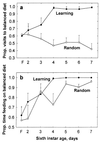Learning improves growth rate in grasshoppers
- PMID: 10706621
- PMCID: PMC15981
- DOI: 10.1073/pnas.050461497
Learning improves growth rate in grasshoppers
Abstract
To quantify the adaptive significance of insect learning, we documented the behavior and growth rate of grasshoppers (Schistocerca americana) in an environment containing two artificial food types, one providing a balanced diet of protein and carbohydrate, which maximizes growth, and the other being carbohydrate-deficient, which is unsuitable for growth. Grasshoppers in the Learning treatment experienced a predictable environment, where the spatial location, taste, and color of each food source remained constant throughout the experiment. In contrast, grasshoppers of the Random treatment developed in a temporally varying environment, where the spatial location, taste, and color of the balanced and deficient food types randomly alternated twice each day. Our results show that the grasshoppers that could employ associative learning for diet choice experienced higher growth rates than individuals of the Random treatment, demonstrating the adaptive significance of learning in a small short-lived insect.
Figures




References
-
- Dukas R. Behav Ecol Sociobiol. 1999;45:195–200.
-
- Lewis W L, Takasu K. Nature (London) 1990;348:635–636.
-
- Turlings T C J, Wackers F L, Vet L E M, Lewis W J, Tumlinson J H. In: Insect Learning. Papaj D R, Lewis A C, editors. London: Chapman and Hall; 1993. pp. 51–78.
Publication types
MeSH terms
LinkOut - more resources
Full Text Sources

